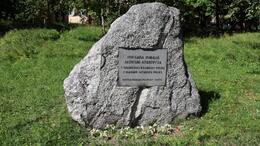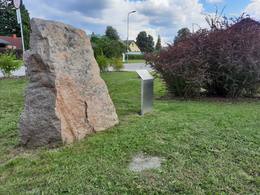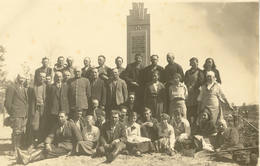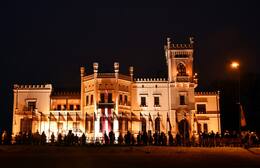Apie Latvijos nepriklausomybės karą ir 1918 metų įvykius Alūksnėje
1918 m., vokiečių kariuomenei įžengus į Alūksnę, latvių šaulių batalionai pasitraukė į Sovietų Rusiją. Iki 1918 m. gruodžio pradžios įsitvirtino vokiškas režimas ir buvo vykdomos pertvarkos. Vokietijai pasidavus kare, bolševikai grįžo į Alūksnę ir atkūrė savo valdžią. Suomijos savanoriai taip pat kovojo Latvijos nepriklausomybės kare kaip Estijos kariuomenės dalis. 1919 m. vasario 21 d. Alūksnėje, prie stoties, vyko įnirtingos kautynės tarp bolševikų ir suomių savanorių pulko „Šiaurės berniukai“.
„1918 metų rudenį vokiečiai paskubomis pasitraukė iš Alūksnės, nes Vokietijoje taip pat kilo revoliucija. Alūksnėje vėl iškilo sovietų valdžia. Vokiečiai Bremžu gatvėje esančioje parduotuvėje paliko daug alkoholinių gėrimų butelių. Raudonieji šauliai nešė butelius į kiemą ir daužė ant akmenų, iš kurių dažniausiai buvo iškepti kiaušiniai, čebakonai kvapniai tekėjo čiuožykla Vidus gatvėje.
Vykdomasis komitetas buvo įsikūręs Alūksnės pilyje. „Kaip vadovaujančius darbuotojus prisimenu Žilį, Samsoną, Egli, Dipaną Ernestą ir milicijos viršininką Bukaną Augustą.
“One evening in February 1919, rifle and machine gun fire could be heard, heralding the approach of the front. In Alūksne, at 11 Alsviķu Street, in a small house on a hill, living in a small room, our mother, sister and I watched all the events in the house. During the night, the sound of shooting got closer and closer. The next morning, cannon shells were already howling over our hut and exploding in the meadow behind the bathhouse. The snow turned black in the explosion holes. In the afternoon, armed Finnish White Guards came down Alsviķu Street. In white winter hats and brown winter boots with their muzzles turned up. Having entered our poor room, they looked around and left. Terror began in Alūksne. (..) A terrible sight opened up on the station hill. There were many fallen people all around in the snow, some even sons of Chinese nationality. (..) A damaged armored train was located at Alūksne station. (..) A few days later, the Baltos carried the fallen heroes piled on sledges to the Alūksne Castle square, where they were buried without coffins in two long common pits. (..) Vykdomasis komitetas evakuotas iš Alūksnės pilies. „Alūksnę paliko ir Raudonosios armijos daliniai“.
Arthuro Kļavos prisiminimai. Alūksnės muziejaus kolekcija. ANM 1701.
Artūras Klava. Laiškas Alūksnės muziejui, 1961 12 21.
Susijusi laiko juosta
Susijusios vietos
Memorial stone to the liberators of Alūksne
Located in Alūksne, at the intersection of Helēnas and Alsviķu streets.
The memorial stone was unveiled on May 29, 1999, the 80th anniversary of the liberation of Alūksne. The stone forging was performed by the sculptor Ainārs Zelčs.
On March 31, 1919, a Northern Latvian brigade was founded in Tartu to liberate Vidzeme and Latgale. The brigade consisted of the combined 1st Valmiera and 2nd Cēsis Infantry Regiment, later also the Northern Latvian Partisan Regiment, two cavalry squadrons and two artillery batteries. On May 26, these forces occupied Valmiera, but on May 27, the 1st Valmiera Infantry Regiment together with the 2nd Estonian Cavalry Regiment attacked in the direction of Alūksne. The Bolsheviks were unable to repel further attacks and on May 29, 1919, Aluksne was liberated.
Memorial stone to the Finnish Volunteer Regiment "Boys of the North"
Located in Alūksne, Jāņkalna Street 52, near Alūksne Narrow Gauge Railway Station.
On February 23, 2019, to mark the centenary of the Latvian War of Independence, a special memorial was created at the initiative of the Association of Independence Fighting Traditions (Finland) to honor the fallen Finnish volunteers, with a special boulder and information board. The memorial stone to Alūksne was removed from the Salpa line in Finland, which was built in 1940-1944. to protect the eastern border of Finland. The 1,200 km long Salpa line is one of the most important lines of defense in independent Finland, as well as one of the strongest and best-preserved defenses of its kind in Europe since World War II.
The stone brought to Aluksne symbolizes the struggle for independence of two nations - the Finns and the Latvians. A group of Finnish volunteers "Northern Boys" went to help Latvians protect the freedom of the new Latvian state. On February 21, 1919, the "Northern Boys" took part in fierce battles around Alūksne (Marienburg). After a five-hour battle at Alūksne railway station, the Finns occupied Alūksne. 23 Finnish volunteers were killed and many injured in the fight.
Monument to the soldiers of Anna Parish who died in the First World War and the Latvian Liberation War
Located in the central part of Anna parish Ezeriņi cemetery.
In the cemetery, where the burials have been made since 1925, there is a monument to the soldiers of Anna Parish who died in the First World War and the Latvian Liberation War, built with the funds collected by the Department of Guard of Anna Parish and unveiled in 1933. Until the Second World War, the guards of Anna Parish took care of the care of the monument, who went to the cemetery every Sunday and laid flowers in honor of the fallen. On November 18, 1940, the monument was shot, and the footprints of the bullets are still visible. Today, the cemetery commemorates Lāčplēsis Day every year.
In 2004, a memorial to the politically repressed in 1941 and 1949 was unveiled in the cemetery, and in 2006 a memorial plaque to the national partisans was unveiled.
Alūksne Museum
The Alūksne Museum is located in an architectural monument of national significance: the neo-Gothic Alūksne New Castle built in the late 19th century. The museum features an exhibition named ‘Memorial Room for Victims of the Totalitarian Regime’, which tells about the fate of the inhabitants of Alūksne municipality in Siberia and the Far East, while the time periods from prehistory to the present meet in the Alūksne history exhibit ‘Feast of the Ages’. It features a separate section devoted to the contribution of the 7th Sigulda Infantry Regiment to the military, culture and public life. The formation of the 7th Sigulda Infantry Regiment began on 20 June 1919 in the Naukšēni Manor. Initially, a battle group of 22 officers and 1,580 soldiers was formed from the reserve battalion of the Northern Latvian Brigade, and was named the Dankers Division. It was included in the 2nd Battalion of the 3rd Jelgava Regiment. On 23 August, following an increase in the number of companies, it became part of the 7th Sigulda Infantry Regiment. Having taken part in the battles against Bermondt, on 5 January 1920, the regiment was transferred to the Latgale front to fight the Bolsheviks. After the signing of the Peace Treaty with Soviet Russia, the regiment guarded Latvia’s eastern border. The Latvian War of Independence saw the deaths of more than 200 soldiers of the regiment, while 85 were awarded the Lāčplēsis War Order. In 1921, the 7th Sigulda Infantry Regiment was stationed in Alūksne. The regiment’s headquarters were set up in the Alūksne New Castle. After World War II, the castle was taken over by Soviet security institutions. As of the late 1950s, the castle housed various cultural institutions: the Culture and Cinematography Department of the Executive Committee, a pioneer house, a library, a cinema and a museum.








